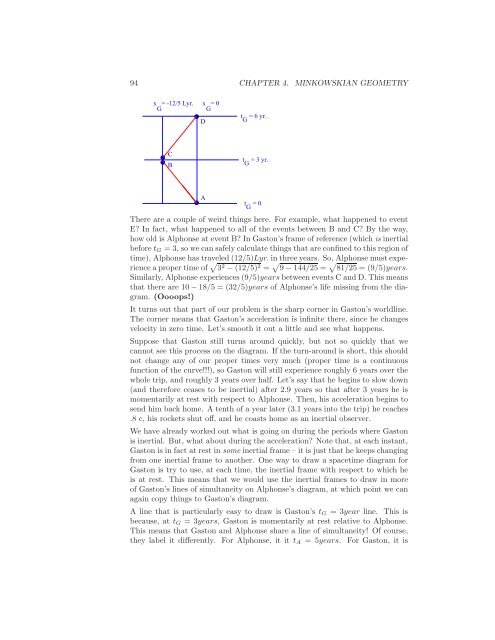Notes on Relativity and Cosmology - Physics Department, UCSB
Notes on Relativity and Cosmology - Physics Department, UCSB
Notes on Relativity and Cosmology - Physics Department, UCSB
You also want an ePaper? Increase the reach of your titles
YUMPU automatically turns print PDFs into web optimized ePapers that Google loves.
94 CHAPTER 4. MINKOWSKIAN GEOMETRY<br />
x = -12/5 Lyr.<br />
G<br />
x = 0<br />
G<br />
D<br />
t = 6 yr.<br />
G<br />
C<br />
B<br />
t = 3 yr.<br />
G<br />
A<br />
t = 0<br />
G<br />
There are a couple of weird things here. For example, what happened to event<br />
E? In fact, what happened to all of the events between B <strong>and</strong> C? By the way,<br />
how old is Alph<strong>on</strong>se at event B? In Gast<strong>on</strong>’s frame of reference (which is inertial<br />
before t G = 3, so we can safely calculate things that are c<strong>on</strong>fined to this regi<strong>on</strong> of<br />
time), Alph<strong>on</strong>se has traveled (12/5)Lyr. in three years. So, Alph<strong>on</strong>se must experience<br />
a proper time of √ 3 2 − (12/5) 2 = √ 9 − 144/25 = √ 81/25 = (9/5)years.<br />
Similarly, Alph<strong>on</strong>se experiences (9/5)years between events C <strong>and</strong> D. This means<br />
that there are 10 − 18/5 = (32/5)years of Alph<strong>on</strong>se’s life missing from the diagram.<br />
(Oooops!)<br />
It turns out that part of our problem is the sharp corner in Gast<strong>on</strong>’s worldline.<br />
The corner means that Gast<strong>on</strong>’s accelerati<strong>on</strong> is infinite there, since he changes<br />
velocity in zero time. Let’s smooth it out a little <strong>and</strong> see what happens.<br />
Suppose that Gast<strong>on</strong> still turns around quickly, but not so quickly that we<br />
cannot see this process <strong>on</strong> the diagram. If the turn-around is short, this should<br />
not change any of our proper times very much (proper time is a c<strong>on</strong>tinuous<br />
functi<strong>on</strong> of the curve!!!), so Gast<strong>on</strong> will still experience roughly 6 years over the<br />
whole trip, <strong>and</strong> roughly 3 years over half. Let’s say that he begins to slow down<br />
(<strong>and</strong> therefore ceases to be inertial) after 2.9 years so that after 3 years he is<br />
momentarily at rest with respect to Alph<strong>on</strong>se. Then, his accelerati<strong>on</strong> begins to<br />
send him back home. A tenth of a year later (3.1 years into the trip) he reaches<br />
.8 c, his rockets shut off, <strong>and</strong> he coasts home as an inertial observer.<br />
We have already worked out what is going <strong>on</strong> during the periods where Gast<strong>on</strong><br />
is inertial. But, what about during the accelerati<strong>on</strong>? Note that, at each instant,<br />
Gast<strong>on</strong> is in fact at rest in some inertial frame – it is just that he keeps changing<br />
from <strong>on</strong>e inertial frame to another. One way to draw a spacetime diagram for<br />
Gast<strong>on</strong> is try to use, at each time, the inertial frame with respect to which he<br />
is at rest. This means that we would use the inertial frames to draw in more<br />
of Gast<strong>on</strong>’s lines of simultaneity <strong>on</strong> Alph<strong>on</strong>se’s diagram, at which point we can<br />
again copy things to Gast<strong>on</strong>’s diagram.<br />
A line that is particularly easy to draw is Gast<strong>on</strong>’s t G = 3year line. This is<br />
because, at t G = 3years, Gast<strong>on</strong> is momentarily at rest relative to Alph<strong>on</strong>se.<br />
This means that Gast<strong>on</strong> <strong>and</strong> Alph<strong>on</strong>se share a line of simultaneity! Of course,<br />
they label it differently. For Alph<strong>on</strong>se, it it t A = 5years. For Gast<strong>on</strong>, it is
















